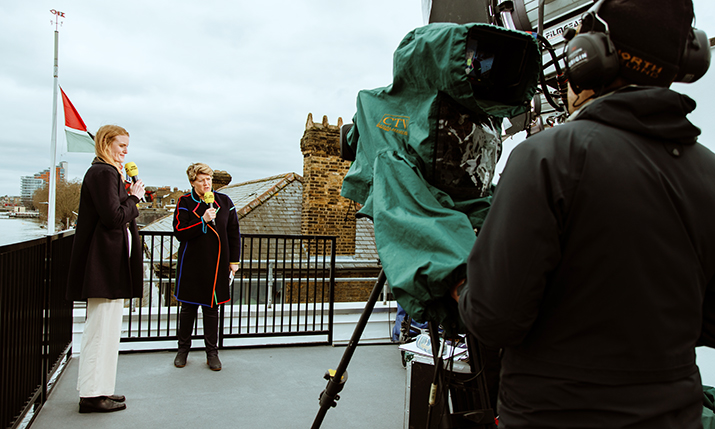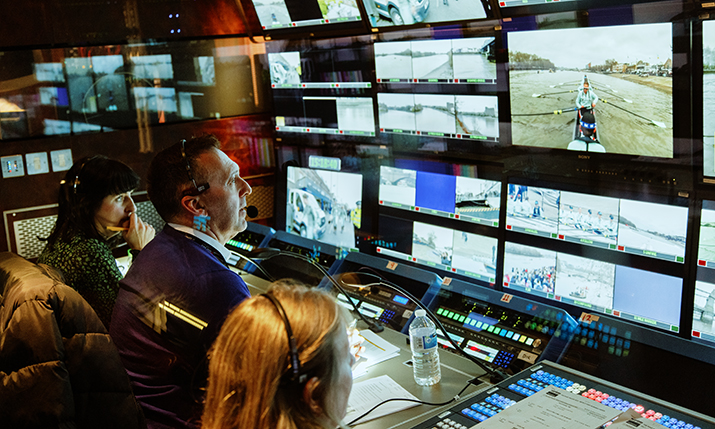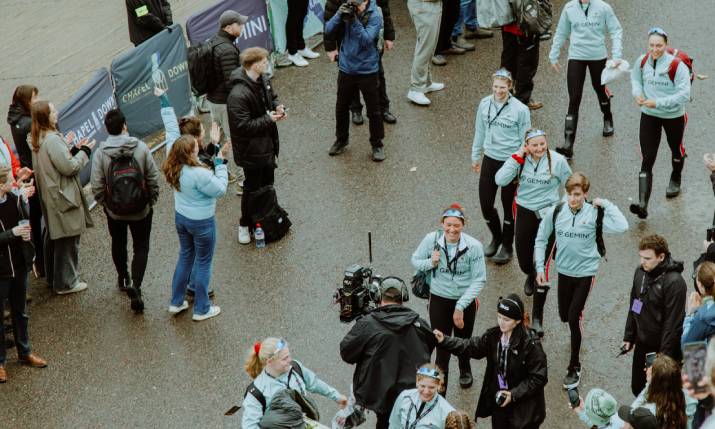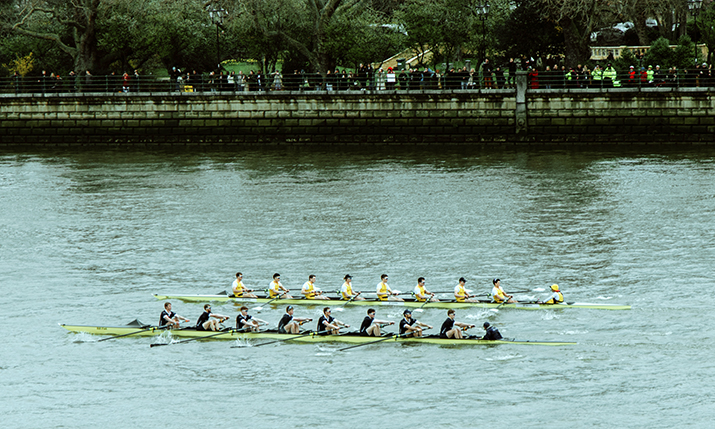Race plan: FilmNova brings drones and IP to The Boat Race with EMG

A hugely experienced presentation line up for the 2023 Boat Race included Clare Balding
With 194 years of rivalry and counting, The Boat Race – where students from Oxford and Cambridge Universities pit themselves against each other on the Thames – has become synonymous with British tradition and excellence.
The 77th Women’s Boat Race and 168th Men’s Boat Race took place on 26 March 2023 on the Thames, with FilmNova working with both EMG and Timeline TV to bring all the thrills and spills to viewers on BBC One, The Boat Race’s own YouTube channel, and over 200 rights holders via the world feed.
Phil Sibson, FilmNova managing director and executive producer of the Boat Race, comments: “We do the BBC’s domestic coverage, including the race, and then we do a separate international feed that we produce as well, which was done remotely from Ealing. So we’re doing both sides of it. We’re the production partner of the BBC, so the technical aspect is contracted directly by the BBC, although we were involved in the tender process for the reappointment of EMG.”
“You can’t try and be too clever. You have to tell the story of what’s happening out there”
While EMG covers all on site technicalities, at Timeline TV in Ealing FilmNova had a producer, a continuity announcer and an EVS operator working on the world feed. That world feed was distributed to over 200 countries.
On how FilmNova came to work on the Boat Race, Sibson says: “Last year the BBC decided that they were going to put out production for the Boat Race to an independent. And we won a competitive tender in December 2021, so we didn’t have that long a buildup to the 2022 race.
“But we did last year’s and then because we did a good job of it, the BBC asked us back to do this year, and we should be carrying on for the next two years as well.”
Race plan
Matthew Coliandris, FilmNova’s race director, comments on the plan for the race: “The BBC let us get on with it for the most part. Don’t forget, we’re inheriting something which has been in place for a very, very long time. So to a certain extent last year we didn’t want to mess with that plan too much because that would’ve just been fool-hearted to come on board at the start of January for something that’s happening at the start of April and say, “well let’s move all these cameras around then”.
“So for the most part we stuck with the plan as was last year. But having done it last year, we thought that there were ways to streamline the coverage and make it more efficient, so we put most of those in place this year.”
“The Cambridge boat had a problem with its rudder. The drone was obviously right over the top of them at that stage, so we were able to show those live pictures of them having their rudder readjusted. And probably if it wasn’t for that shot, we probably wouldn’t have known about it”
The biggest difference implemented is that previously, the race was completed with two OB trucks – one at the start in Putney and one at the end in Mortlake – each with separate crews, including directors. Thanks to EMG bringing in IP connectivity, the race was managed from the main truck at the start of the race for the first time this year, while an OB was in place at the end of the race as part of the disaster recovery plan.
Comments Coliandris: “We’ve now pulled all that control back so that Putney – the start OB and the main race OB – does the entire event. The entire race is now directed from Putney and all the press elements are also directed from Putney as well. So we still have an OB at Mortlake because it’s able, should there be catastrophic failure at Putney in terms of broadcast, to still put the broadcast to air; it can receive a certain amount of our cameras.”
He adds: “Part of the reason why this has never happened before is because the technology’s never existed before, to be able to get all those cameras back from the finish.”
Sibson says of the technology being used: “So we’re now using dark fibre; it’s an IP mesh that EMG is using. Previously it was done through street access lease lines. So whereas they didn’t have capacities bring all the cameras back to Putney previously, they can now bring them all back and vice versa; if anything went down at Putney, they’ve got cameras at Mortlake that would allow them to do the same.”

Camera plans
The FilmNova team delivered a highly complex OB involving 31 cameras across the 4.2 mile course. The camera spec included use of a helicopter, two drones – one for the race and one for the warm up – and live feeds from minicams showing the cox and stroke athletes on each of the Oxford and Cambridge boats as they raced.
The camera plan is quite complex for this very fast race. Coliandris says: “We try and build a plan whereby we bring those cameras into coverage in conjunction with the mobile cameras we’ve got; the cameras on the water and the aerial cameras. We draw up a flight plan for the helicopter, for instance, which puts him in a certain position at a certain time, which coincides very nicely to the next camera we’re going to on the land and vice versa, so we never have a clash. We never have a position where a set of boats are going from left to right, and then the next thing you know they’re going from right to left.
“We do the same with the drones; we give them moves. We just don’t want them to follow two boats, two crews down the course. We just want to be moving them around, we want them to be in front, behind, left, right. So quite a lot of planning goes into putting that together for two of what are our most dynamic cameras.
On the drones, Sibson comments: “Last year was the first time there’d been drones allowed on the Thames Highway. The BBC had to take credit for that because when in lockdown, when the boat race had to move to Ely, they were able to use drones for the first time in Ely and were able to show exactly how they would use them, which then meant that they could get the necessary permissions on the Thames Highway to use them.
“We used the drone last year for the first time. And then this year we were able to use two. We had one for the race, which was flown from a boat following the flotilla, and it actually had to land back down on the boat to go under Hammersmith Bridge before it could go back up again.
“And then there was a drone that was specifically to cover the warm up, because when the boats first enter the water, they go the other way [to the race course]. They don’t go down the course, they go the other side of Putney Bridge. None of the fixed cameras are that way and in the past [the boat crews] have known that they can go there to get away from the cameras. But now we’ve got drones!”
Unfolding stories
This year the new warm up drone was able to capture a story unfolding on the Cambridge boat, which would eventually go on to win the race, but which could have had a very different outcome. Coliandris explains: “The Cambridge boat had a problem with its rudder. The drone was obviously right over the top of them at that stage, so we were able to show those live pictures of them having their rudder readjusted. And probably if it wasn’t for that shot, we probably wouldn’t have known about it.
“There are 23 race cameras to try and get into that coverage and we want to get them all in. So given those boats and those aerial cameras, with our plan – to a certain extent – I don’t need to direct them because I’ve already told them months in advance what I want to do”
“The boat race crews are very protective of what they’re doing, as you can imagine. So as Phil says, disappearing off to Wandsworth was usually the ideal scenario for them; out of sight, out of mind. But now we can actually see what they’re up to.
“That was one of the first things we thought of last year actually. We come on the air and we talk about two crews, but because they’re on the other side of Putney Bridge you can’t see them,” continues Coliandris. “So we put in place a situation whereby we could actually get live pictures of them while they’re out on the water.
“As it was the rudder got fixed and the race went off on time, but that might not have been the case; we might have been delayed by 10 or 15 minutes and we can’t be delayed much longer than that before the boats came out on the shore with the high tide. But at least we were in a position whereby we were able to tell a story which could have actually developed further.”
 Directing control
Directing control
There were still two directors working on the day, with one covering the race itself and the other the presentation. Coliandris explains why this was necessary: “We split the presentation and the race direction solely because of what happens on event day. It’s largely in the lead up; there’s so much to test within the race truck and rehearse that you would not have enough time to be able to run through presentation properly. You couldn’t dedicate enough time to reporters and presenters because you would just have too much to do with the race. So that’s why we split that element and it just makes it a lot more straightforward and a lot smoother when it comes to TX day.”
Coliandris, as race director, was faced with maintain the long heritage of this race while improving the coverage as much as possible this year. He comments: “You’re always totally in the lap of the gods in terms of what happens out on the water. And the races this year, particularly from start to Hammersmith Bridge of both races, there was a lot going on this year, and for the men’s race there was a lot going on from beginning to end.
“You can’t try and be too clever. You have to tell the story of what’s happening out there,” he continues. “Certainly for the first half of the men’s race, you just have to pay attention to what’s happening on the water. We put plans in place for the helicopter to be in a certain place and the drone to be in a certain place, but that was in conjunction with what was happening in the race live. It’s a very, very quick race. They’re 18 to 20 minutes depending on conditions, so there’s a lot to get in.
“There are 23 race cameras to try and get into that coverage and we want to get them all in. So given those boats and those aerial cameras, with our plan – to a certain extent – I don’t need to direct them because I’ve already told them months in advance what I want to do.
“The helicopter is the obvious one. It has to have a flight plan. “I need you to be over the north bank of the river at this point. I need you to be south bank there. I need you to move around the back at this point.” So the helicopter will just fly that route and then it just slots in nicely and it compliments with all the other cameras on the ground or on the water,” Coliandris states.
Challenges on water
This year the weather and the rowers themselves created a few challenges for the FilmNova team. Sibson says: “The weather was certainly challenging in the lead up. The week before was shocking, and for the [crew] out on the water in particular, it’s really tough. The drone is the one camera which is affected by weather conditions more than any other. We probably never saw the drone in anger until the women’s race went off on Sunday, and even then, would you believe it or not, [the drone operator’s] boat had an engine problem. So there are challenges. It’s a big OB. It’s very complicated OB, and it’s subject to weather conditions. So an awful lot has got to go right for you for everything to work.”
Adds Coliandris: “Another challenge that’s quite interesting is that there are two onboard cameras on each boat. One that looks back at the cox, which is positioned low down in the boats, and one on a mast behind the cox looking ahead of the crew. When crews take the boats out in the water, they have to tip the boats upside down as they put them into the water. On the Cambridge boat, they managed to put the camera on the mast in the water. You’re sat there going “oh, careful!”, but it went in the water, which consequently made it cut out. We lost the images from looking back at the crew.
“But we were then able to switch to the cox” camera in that boat. So at least we had something. But then when they had the rudder problems, they accidentally switched the camera off. So we then had to ask the umpire for permission just before the race to switch it back on again. The umpire originally said no, and then changed their mind, and luckily the cox was able to switch it on for us, so we had a camera looking back at the cox for Cambridge, but not one looking at the rest of the boats unfortunately.”
The boat crews know how to operate the onboard cameras, and use that to their advantage sometimes, notes Coliandris. “It sort of feeds into the element that these crews don’t like to give a lot away to the opposition so for a lot of the time they do turn those cameras off anyway. There are a lot of third party elements within this OB that can give you a little bit of a headache, weather being number one, but also technical elements on vehicles or in this case boats or helicopters.
“You just cannot mitigate against every single element in that regard,” Coliandris continues. “So if you get the whole TV bit working and then you find out that the engine on one of the boats has this water pump that needs replacing, for instance, just before the start of the women’s race – and that happened – you have to accept it as there’s always something. It’s a big OB, it’s complicated, so not all of it’s going to work all the time.”
A hugely experienced presentation line-up included Clare Balding, Andrew Cotter, Lee McKenzie, Katherine Grainger, Zoe De Toledo, James Cracknell, Helen Glover, Grace Prendergast, Kyra Edwards, Martin Cross, Angus Groom, Qasa Alom, Matthew Holland, Wayne Pommen and Andy Triggs Hodge.
FilmNova was on air with the BBC between 3:30pm and 5:45pm on 26 March 2023.


